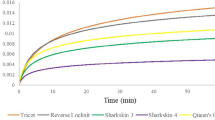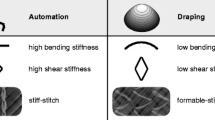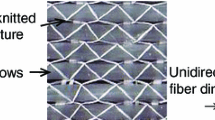Abstract
Non-crimp fabrics (NCFs) enable relatively high mechanical properties by keeping the reinforcement tows straight. Handling of those fabrics is improved by stitching the reinforcement tows together. While the stitching has little structural influence on the final part, it highly affects the NCFs capability to shear and drape over a mold during preforming. High tensile strain in the stitching yarn has been correlated to the NCF resistance to shearing and even adverse drape defects such as tow undulations. Furthermore, stitching causes the shear behavior of the fabric to be anisotropic, with different behavior in positive and negative shear. In the current study, a model based on the stitching geometry and reinforcement tow directions has been created to find the tensile strain in the stitching yarn as the NCF is being sheared. It was found that the stitch angle was the main driving stitching parameter, and that this angle could be selected so that shearing in both positive and negative directions produces no tensile strain in the stitching yarn. The model showed good correlation with uniaxial bias-extension and drape tests for NCFs with different stitching parameters. Finally, design charts are displayed which can be used to select the stitching parameters of standard industrial NCF-machines which results in NCFs with near-symmetric shear behavior and thus good shear and draping performance.


















Similar content being viewed by others
References
Laessig R, Eisenhut M, Mathias A, Schulte R, Peters F, Kuehnemann T et al (2012) Series production of high-strength composites: Perspectives for the german engineering industry
Middendorf P, Metzner C (2011) Aerospace applications of non-crimp fabric composites. In: Lomov S (ed) Non-crimp fabric composites: Manufacturing, properties and applications. Oxford and Philadelphia: Woodhead Publishing
Skoeck-Hartmann B, Gries T (2011) Automotive applications of non-crimp fabric composites. In: Lomov S (ed) Non-crimp fabric composites: Manufacturing, properties and applications. Oxford and Philadelphia: Woodhead Publishing
Lomov S, Barburski M, Stoilova T, Verpoest I, Akkerman R, Loendersloot R et al (2005) Carbon composites based on multiaxial multiply stitched preforms. part 3: Biaxial tension, picture frame and compression tests of the preforms. Compos A: Appl Sci Manuf 36(9):1188–1206
Spencer DJ (2001) Knitting technology: A comprehensive handbook and practical guide, 3rd edn. Lancaster and Cambridge, Technomic
Schnabel S, Gries T (2011) Production of non-crimp fabrics for composites. In: Lomov S (ed) Non-crimp fabric composites: Manufacturing, properties and applications. Oxford and Philadelphia: Woodhead Publishing
Lomov S (2011) Understanding and modelling the effect of stitching on the geometry of non-crimp fabrics. In: Lomov S (ed) Non-crimp fabric composites: Manufacturing, properties and applications. Oxford and Philadelphia: Woodhead Publishing
Lomov SV (2011) Deformability of textile preforms in the manufacture of non-crimp fabric composites. In: Lomov S (ed) Non-crimp fabric composites: Manufacturing, properties and applications. Oxford and Philadelphia: Woodhead Publishing
Kong H, Mouritz AP, Paton R (2004) Tensile extension properties and deformation mechanisms of multiaxial non-crimp fabrics. Compos Struct 66(1–4):249–259
Bel S, Boisse P, Dumont F (2012) Analyses of the deformation mechanisms of non-crimp fabric composite reinforcements during preforming. Appl Compos Mater 19:513–528
Long A, Souter B, Robitaile F (2000) A fabric mechanics approach to draping of woven and non- crimp reinforcements. 15th Technical Conference American Society for Composites: College Station, Texas
Long A, Souter B, Robitaille F (1999) Effects of fibre architecture on deformation during preform manufacture. ICCM-12, TCA
Yu WR, Harrison P, Long A (2005) Finite element forming simulation for non-crimp fabrics using a non-orthogonal constitutive equation. Compos Part A 36:1079–1093
Harrison P, Yu W, Long A (2011) Modelling the deformability of biaxial non-crimp fabric composites. In: Lomov S (ed) Non-crimp fabric composites: Manufacturing, properties and applications. Oxford and Philadelphia: Woodhead Publishing
Harrison P, Wiggers J, Long AC, Rudd CD (2000) Constitutive modelling based on meso and micro kinematics for woven and stitched fabrics. 15th Technical Conference American Society for Composites: College Station, Texas
Wiggers J, Long A, Harrison P, Rudd C (2003) The effects of stitch architecture on the shear compliance of non-crimp fabrics. Proceedings of 6th International ESAFORM Conference on Material Forming, Salerno, Italy, pp 851–4
Lee J, Hong S, Yu W, Kang T (2007) The effect of blank holder force on the stamp forming behavior of non-crimp fabric with a chain stitch. Compos Sci Technol 67:357366
Bel S, Hamila N, Boisse P, Dumont F (2012) Finite element model for ncf composite reinforcement preforming: Importance of inter-ply sliding. Compos Part A 43:22692277
Dumont F, Weimer C, Soulat D, Launay J, Chatel S, Maison-Le-Poec S (2008) Composites preforms simulations for helicopters parts. Int J Mater Form 1:847850
Chen S, McGregor O, Harper L, Endruweit A, Warrior N (2016) Defect formation during preforming of a bi-axial non-crimp fabric with a pillar stitch pattern. Compos Part A 91:156–167
Li L, Zhao Y, Vuong H, Chen Y, Yang J, Duan Y (2014) In-plane shear investigation of biaxial carbon non-crimp fabrics with experimental tests and finite element modeling. Mater Des 63:757–765
Samir D, Hamid S (2013) Determination of the in-plane shear rigidity modulus of a carbon non- crimp fabric from bias-extension data test. J Compos Mater 48:2729–2736
(2013) Handbuch Faserverbundkunststoffe/Composites. Springer Fachmedien Wiesbaden, Wiesbaden
Du G, Ko F (1996) Analysis of multiaxial warp-knit preforms for composite reinforcement. Compos Sci Technol 56(3):253–260
Robitaille F, Clayton B, Long A, Souter B, Rudd C (2000) Geometric modelling of industrial preforms: Warp-knitted textiles. Proc Inst Mech Eng Part L J Mater Des Appl 214(2):71–90
Ko F, Bruner J, Pastore A, Scardino F (1980) Development of multi-bar weft-insert warp knit glass fabrics for industrial applications. J Eng Ind 102(4):333
Creech G, Pickett A (2006) Meso-modelling of non-crimp fabric composites for coupled drape and failure analysis. J Mater Sci 41(20):6725–6736
Sirtautas J, Pickett AK, Lepicier P (2013) A mesoscopic model for coupled drape-infusion simulation of biaxial non-crimp fabric. Compos Part B 47:48–57
Long A (2005) Design and manufacture of textile composites. Woodhead, Cambridge
Boisse P, Hamila N, Guzman-Maldonado E, Madeo A, Hivet G, Dell’Isola F (2016) The bias- extension test for the analysis of in-plane shear properties of textile composite reinforcements and prepregs: a review. Int J Mater Form. doi:10.1007/s12289-016
Mack C, Taylor H (2006) The fitting of woven cloths to surfaces. J Text Inst 47:477–488
Launay J, Hivet G, Duong AV, Boisse P (2008) Experimental analysis of the influence of tensions on in plane shear behaviour of woven composite reinforcements. Compos Sci Technol 68(2):506–515
Harrison P, Clifford M, Long A (2004) Shear characterisation of viscous woven textile composites: a comparison between picture frame and bias extension experiments. Compos Sci Technol 64:1453–1465
Krieger H, Schnabel A, Appel L, Gries T (2013) Experimental setup to validate textile material models for drape simulation. Key Eng Mater 554-557:456–464. doi:10.4028/www.scientific.net/KEM.554-557.456
Author information
Authors and Affiliations
Corresponding author
Ethics declarations
Funding
This research did not receive any specific grant from funding agencies in the public, commercial, or not-for-profit sectors.
Conflict of Interest
The authors declare that they have no conflict of interest.
Rights and permissions
About this article
Cite this article
Krieger, H., Gries, T. & Stapleton, S.E. Shear and drape behavior of non-crimp fabrics based on stitching geometry. Int J Mater Form 11, 593–605 (2018). https://doi.org/10.1007/s12289-017-1368-1
Received:
Accepted:
Published:
Issue Date:
DOI: https://doi.org/10.1007/s12289-017-1368-1




